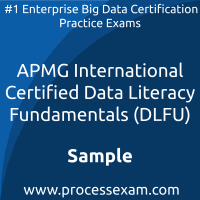 You have to pass the DLFU exam to receive the certification from APMG International. To increase the effectiveness of your study and make you familiar with the actual exam pattern, we have prepared this APMG International Data Literacy Fundamentals sample questions. Our Sample APMG International Data Literacy Fundamentals Practice Exam will give you more insight about both the type and the difficulty level of the questions on the APMG International Data Literacy Fundamentals exam.
You have to pass the DLFU exam to receive the certification from APMG International. To increase the effectiveness of your study and make you familiar with the actual exam pattern, we have prepared this APMG International Data Literacy Fundamentals sample questions. Our Sample APMG International Data Literacy Fundamentals Practice Exam will give you more insight about both the type and the difficulty level of the questions on the APMG International Data Literacy Fundamentals exam.
However, we are strongly recommending practice with our Premium APMG International Certified Data Literacy Fundamentals (DLFU) Practice Exam to achieve the best score in your actual APMG International DLFU Exam. The premium practice exam questions are more comprehensive, exam oriented, scenario-based and exact match of APMG International Data Literacy Fundamentals exam questions.
APMG International Data Literacy Fundamentals Sample Questions:
01. Why is data ethics important in today’s data-driven world?
a) To avoid collecting personal data
b) To increase data complexity
c) To ensure responsible and fair use of data
d) To prevent software updates
02. When interpreting a line chart, which of the following could indicate a significant event or shift?
a) Sudden drop or rise
b) Consistent horizontal line
c) Repeated labels
d) Missing gridlines
03. In a box plot, what does the line inside the box typically represent?
a) The maximum value
b) The median
c) The mean
d) The variance
04. When would you use the median instead of the mean in a dataset?
a) When data is categorical
b) When you have missing values
c) When outliers are present
d) When the data is perfectly symmetrical
05. ________ data is commonly used for classification purposes and has limited unique values such as 'Male' or 'Female'.
a) Categorical
b) Numerical
c) Ordinal
d) Boolean
06. Which statistical measure best describes the "spread" or "variability" of values in a dataset?
a) Average
b) Mean
c) Standard deviation
d) Mode
07. Why is it important to know your audience when telling a data story?
a) To avoid asking questions
b) To decide how much raw data to include
c) To determine which software to use
d) To adjust the complexity and context of your insights
08. How can organizations promote data literacy among employees?
a) Providing regular training
b) Encouraging the use of personal data sets
c) Integrating data skills into onboarding
d) Limiting access to dashboards
09. Which outcome best illustrates the strategic impact of data literacy on business performance?
a) Enhanced analytical decision-making
b) Automated backups of data systems
c) Faster installation of software tools
d) Reduction in email communication
10. What is the primary advantage of using a bar chart?
a) It shows changes over time
b) It visualizes relationships between variables
c) It tracks cumulative totals
d) It displays individual category comparisons
Answers:
Question: 01
Answer: c |
Question: 02
Answer: a, b |
Question: 03
Answer: b |
Question: 04
Answer: c |
Question: 05
Answer: a |
Question: 06
Answer: c |
Question: 07
Answer: d |
Question: 08
Answer: a, c |
Question: 09
Answer: a |
Question: 10
Answer: d |
If you find any errors or typos in APMG International Certified Data Literacy Fundamentals (DLFU) sample question-answers or online APMG International Data Literacy Fundamentals practice exam, please report them to us on feedback@processexam.com
 You have to pass the DLFU exam to receive the certification from APMG International. To increase the effectiveness of your study and make you familiar with the actual exam pattern, we have prepared this APMG International Data Literacy Fundamentals sample questions. Our Sample APMG International Data Literacy Fundamentals Practice Exam will give you more insight about both the type and the difficulty level of the questions on the APMG International Data Literacy Fundamentals exam.
You have to pass the DLFU exam to receive the certification from APMG International. To increase the effectiveness of your study and make you familiar with the actual exam pattern, we have prepared this APMG International Data Literacy Fundamentals sample questions. Our Sample APMG International Data Literacy Fundamentals Practice Exam will give you more insight about both the type and the difficulty level of the questions on the APMG International Data Literacy Fundamentals exam.